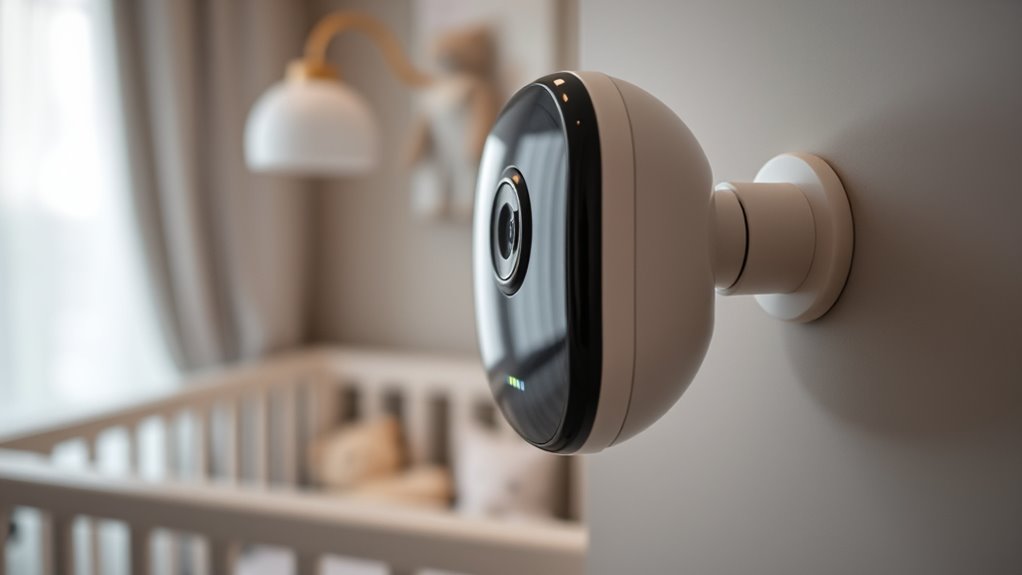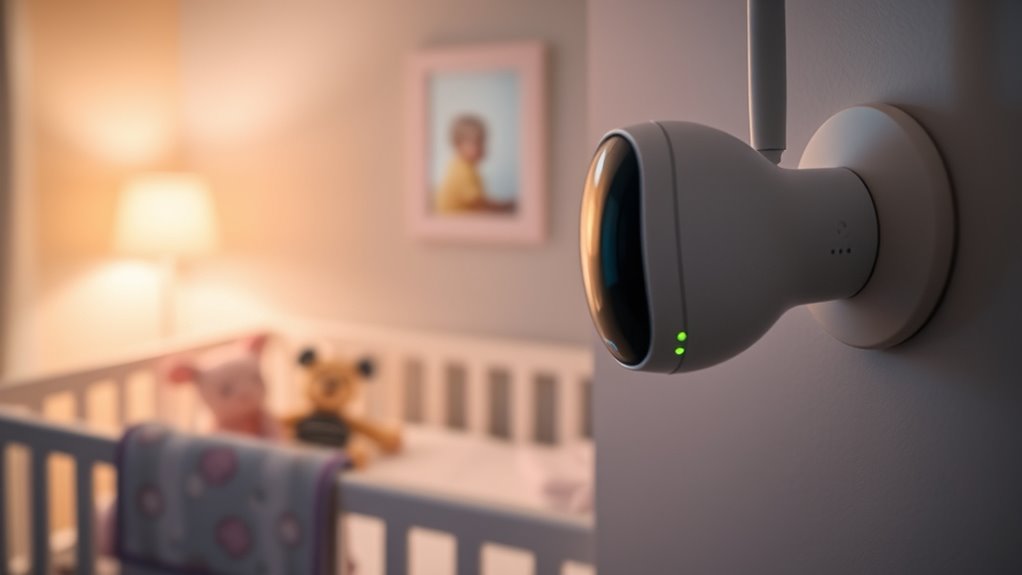Smart baby monitors can invade your privacy when security isn’t tight enough, exposing your family’s private moments to hackers. These devices often transmit video and audio over Wi-Fi, and weak passwords or outdated software make it easier for cybercriminals to access live feeds or stored footage. Data breaches could lead to identity theft or blackmail. If you want to know more about protecting your family’s privacy, keep exploring the details on how risks can be minimized.
Key Takeaways
- Many smart baby monitors lack proper security measures, increasing the risk of unauthorized access and privacy breaches.
- Data transmitted over Wi-Fi can be intercepted if encryption and secure protocols are not implemented.
- Manufacturers may collect and share user data without clear consent, risking exposure of private family moments.
- Regular updates, strong passwords, and security features are essential to protect against hacking and data theft.
- Balancing child safety with privacy requires informed usage, minimal data sharing, and vigilance over device permissions.

As smart baby monitors become increasingly popular in homes, concerns about privacy risks grow alongside their convenience. These devices offer real-time video and audio feeds, giving parents peace of mind about their little ones. But they also open doors to potential privacy invasions, especially when it comes to data breaches and parental surveillance. You might think that simply keeping an eye on your baby is harmless, but the data transmitted by these monitors can be vulnerable if not properly secured. Cybercriminals have targeted connected devices before, exploiting weak security protocols to access personal footage and sensitive information. When a data breach occurs, your private moments could be exposed or stolen, leaving your family vulnerable to identity theft or blackmail.
Smart baby monitors can expose your privacy if not properly secured, risking data breaches and personal information theft.
The rise of parental surveillance through these devices means you’re constantly watching and being watched. While it’s comforting to monitor your child’s safety, it also raises questions about how much of your family life is being shared and stored online. Many baby monitors connect to Wi-Fi, which makes data transmission convenient but also risky. If the monitor’s manufacturer doesn’t implement robust security measures—like encryption and secure login protocols—your data could be intercepted during transmission. Hackers could gain access to live feeds or stored footage, often without your knowledge. Such breaches not only compromise your privacy but also undermine the trust you place in these devices. Additionally, the security vulnerabilities in many of these products highlight the importance of choosing reputable brands that prioritize data protection.
Furthermore, some manufacturers collect and store user data, sometimes sharing it with third parties without clear consent. This practice can lead to unintended exposure of personal information, which might be used for targeted advertising or other purposes. You may not realize that your child’s images or your location data are being stored on servers that could be vulnerable or misused. It’s vital to understand the privacy policies of your device and choose products from reputable companies that prioritize security and transparency. Implementing best security practices can significantly reduce your risk of data breaches and protect your family’s sensitive information.
While parental surveillance is often viewed as a necessary tool for child safety, it shouldn’t come at the expense of your privacy. You need to stay informed about the risks associated with these devices. Regularly updating firmware, changing default passwords, and enabling security features can help protect your data. You should also be aware of device vulnerabilities that could be exploited by malicious actors. Be cautious about the information you share and the permissions you grant. Ultimately, the convenience of smart baby monitors shouldn’t overshadow the importance of safeguarding your family’s privacy. Staying vigilant and informed ensures you can keep your child safe without exposing yourself to unnecessary risks.
Frequently Asked Questions
Can Hackers Access Smart Baby Monitors Remotely?
Hackers can access smart baby monitors remotely through device vulnerabilities if you don’t secure them properly. These vulnerabilities may include weak passwords or outdated firmware, putting your user privacy at risk. To protect yourself, regularly update your device, change default passwords, and enable two-factor authentication. Staying vigilant helps prevent unauthorized access, ensuring your baby’s safety and maintaining your privacy in an increasingly connected world.
Do Manufacturers Share Data With Third Parties?
Many manufacturers do share data with third parties, often for analytics or advertising purposes, which may concern parents worried about privacy. You should check the company’s privacy policy to understand their data sharing practices. Using robust parental controls helps protect your child’s information and limits data access. Being aware of how your monitor handles data can help you make informed decisions, ensuring your family’s privacy remains secure while using these devices.
Are There Legal Regulations Governing Monitor Privacy?
Imagine your privacy as a delicate fortress—you want it protected. Laws and regulations act as the sentinels guarding it. You need to check privacy policies to understand how your data’s handled and verify manufacturers follow legal compliance. While regulations vary by region, many countries have enacted laws to safeguard your rights, but always stay vigilant. Your privacy depends on knowing these rules and demanding transparency from device makers.
How Secure Are Wireless Connections for These Devices?
Wireless connections for smart baby monitors can be quite secure if you guarantee strong wireless encryption and proper device authentication. You should use WPA3 or WPA2 encryption on your Wi-Fi network and enable two-factor authentication where possible. Regularly updating your device’s firmware also helps protect against vulnerabilities. While no system is completely invulnerable, these steps greatly reduce the risk of unauthorized access to your monitor’s video and audio feeds.
What Steps Can Parents Take to Protect Their Privacy?
To safeguard your privacy when using smart baby monitors, you should regularly review and update your privacy settings and enable strong, unique passwords. Use parental controls to restrict access and monitor activity. Always keep the device’s firmware updated to patch security vulnerabilities. Avoid sharing camera feeds publicly, and disconnect the device when not in use. These steps help ensure your child’s safety and your privacy remains secure.
Conclusion
As you navigate the world of smart baby monitors, remember they’re like double-edged swords—offering peace of mind but lurking with privacy pitfalls. Think of them as watchful guardians, yet sometimes they whisper secrets you didn’t intend to share. Stay vigilant, set clear boundaries, and keep your digital fortress strong. Only then can you enjoy the comforting glow of technology without letting it cast shadows over your privacy’s delicate garden. Guard it well, and trust your instincts.









